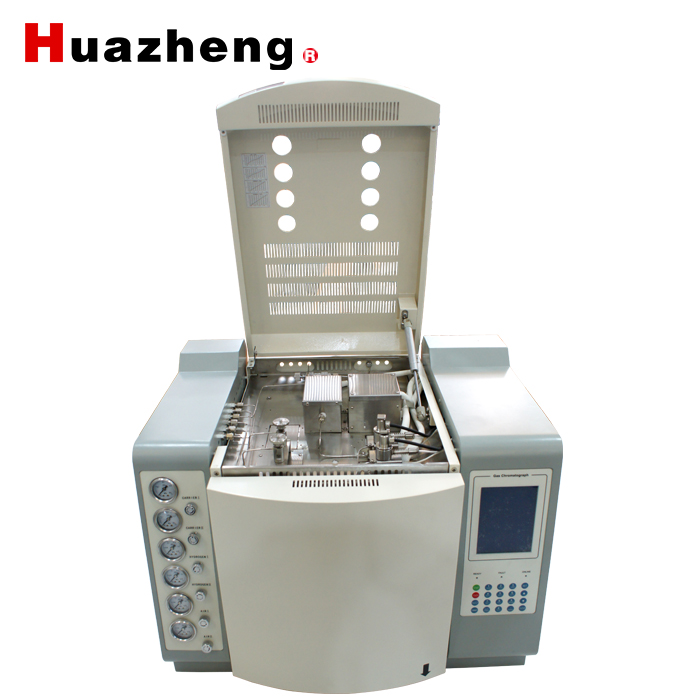Time: 2021-12-30 Author: 铧正 Click: 1703 Time

The gas chromatograph mainly uses the difference of the boiling point, polarity and adsorption properties of the substance to realize the separation of the mixture. After the sample to be analyzed is vaporized in the gasification chamber, the inert gas (ie carrier gas, also known as the mobile phase) is brought into the chromatographic column. The column contains a liquid or solid stationary phase. Each component in the sample tends to be in the mobile phase and A distribution or adsorption equilibrium is formed between the stationary phases. With the flow of the carrier gas, the sample components are repeatedly distributed or adsorbed/desorbed during the movement. The components with large concentrations in the carrier gas flow out of the chromatographic column first, and the components with large concentrations are distributed in the stationary phase. After flowing out. After the components flow out of the chromatographic column, they enter the detector to be measured.
How to improve the sensitivity of gas chromatography without increasing the sample concentration?
"Sensitivity" refers to the magnitude of the electrical signal (voltage: mV, current: mA) generated when a certain amount of component passes through the detector.
Improving instrument sensitivity is an eternal topic in analytical chemistry. As far as GC analysis is concerned, instrument manufacturers and analysts always try to make high-sensitivity instruments and develop high-sensitivity methods. It is this demand that promotes the development of the instrument, and the development of the instrument has caused the regulatory manufacturers to propose higher detection sensitivity requirements. This interaction is cyclical. So how can the sensitivity be improved without increasing the sample concentration?
Cause Analysis:
The reasons for the reduced sensitivity may include:
1. Split injection is used.
2, the sample does not completely enter the chromatographic column.
3. The instrument is contaminated, especially the injection port and the chromatographic column, which causes the system noise to increase, which masks the response of the compound.
4. The compound is easily adsorbed by the active site at the injection port, and there is a matrix effect.
5. The sensitivity of the selected detector is reduced.
solution:
There are several ways to improve detection sensitivity:
①Splitless injection: The so-called splitless injection means that the solenoid valve of the split gas circuit is closed when sampling, so that all the samples are injected into the chromatographic column. This can improve sensitivity and eliminate diversion discrimination. The sensitivity of splitless injection is significantly higher than that of split injection, but the background signal will also increase. It is usually used for environmental analysis (such as monitoring of trace pollutants in water and atmosphere), pesticide residue detection in food, and clinical and pharmaceutical analysis.
②Select a specific and highly sensitive detector: This is also a common method for chromatographers to improve sensitivity. For example, ECD is used when analyzing halogen-containing compounds, NPD is used when analyzing nitrogen and phosphorus compounds, and FPD is used when analyzing sulfur and phosphorus compounds. Of course, general-purpose detectors with higher sensitivity such as mass spectrometry detectors (MSD) can also be used.
③Maintain the instrument and reduce system noise: The instrument system noise usually comes from two aspects: one is the instrument itself, such as detector noise, circuit noise, stationary phase loss, etc.; the other is the sample matrix, such as the injection solution contains many impurities, pick up High background noise may cause contamination of the injection port and column system. The former can be suppressed by using selective detectors and low-loss chromatographic columns; the latter requires sample purification, such as solid phase extraction (SPE) or other methods to eliminate sample matrix interference, and timely replacement of liners, cleaning systems, etc. .
④The injection port uses a deactivated liner: the active sites on the liner may adsorb the components to be tested, causing chromatographic peak tailing, reducing sensitivity and affecting reproducibility. When splitless injection or analysis of slightly polar compounds, the use of a deactivated liner with high inertness, low loss and good thermal stability can often significantly improve the sensitivity of active substances that were difficult to solve in previous analyses. It is suitable for Analysis of complex matrices and active substances.
⑤Use a chromatographic column with no pollution and low fixative loss: After the column is used for a long time, the fixative loss is serious, which leads to the adsorption of the sample by the exposed carrier. Part of the carrier will become more and more, because of the existence of its active sites, it will cause the components to be analyzed in the analysis process to directly contact the surface of the carrier to produce adsorption. At the same time, the loss of stationary phase will raise the chromatographic baseline, which will reduce the sensitivity. .
⑥ Use matrix to prepare standard solutions to improve sensitivity: In GC analysis, matrix effects are often encountered, which seriously affects the accuracy and precision of the results. For example, organophosphorus pesticides with a smaller molecular weight are more susceptible to the influence of the matrix, showing a matrix enhancement effect. Due to the existence of the matrix, the active sites on the injection port liner and the chromatographic column are covered, and the active sites and the substance to be tested are reduced. The opportunity of contact, so that the signal of the substance to be tested is enhanced. Therefore, the matrix extract with the same composition as the sample solution should be used as the diluent of the compound as much as possible to improve the sensitivity of the test compound.